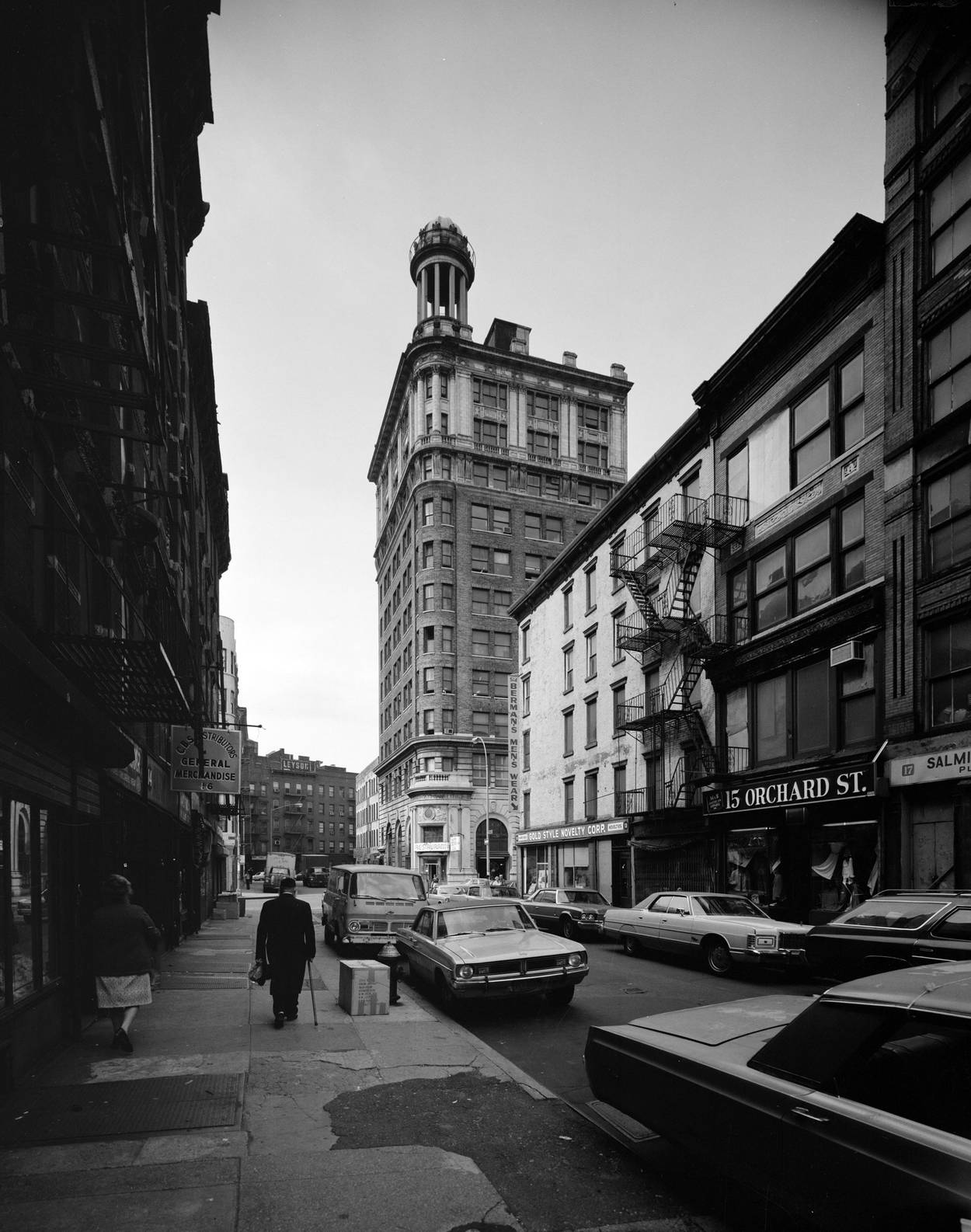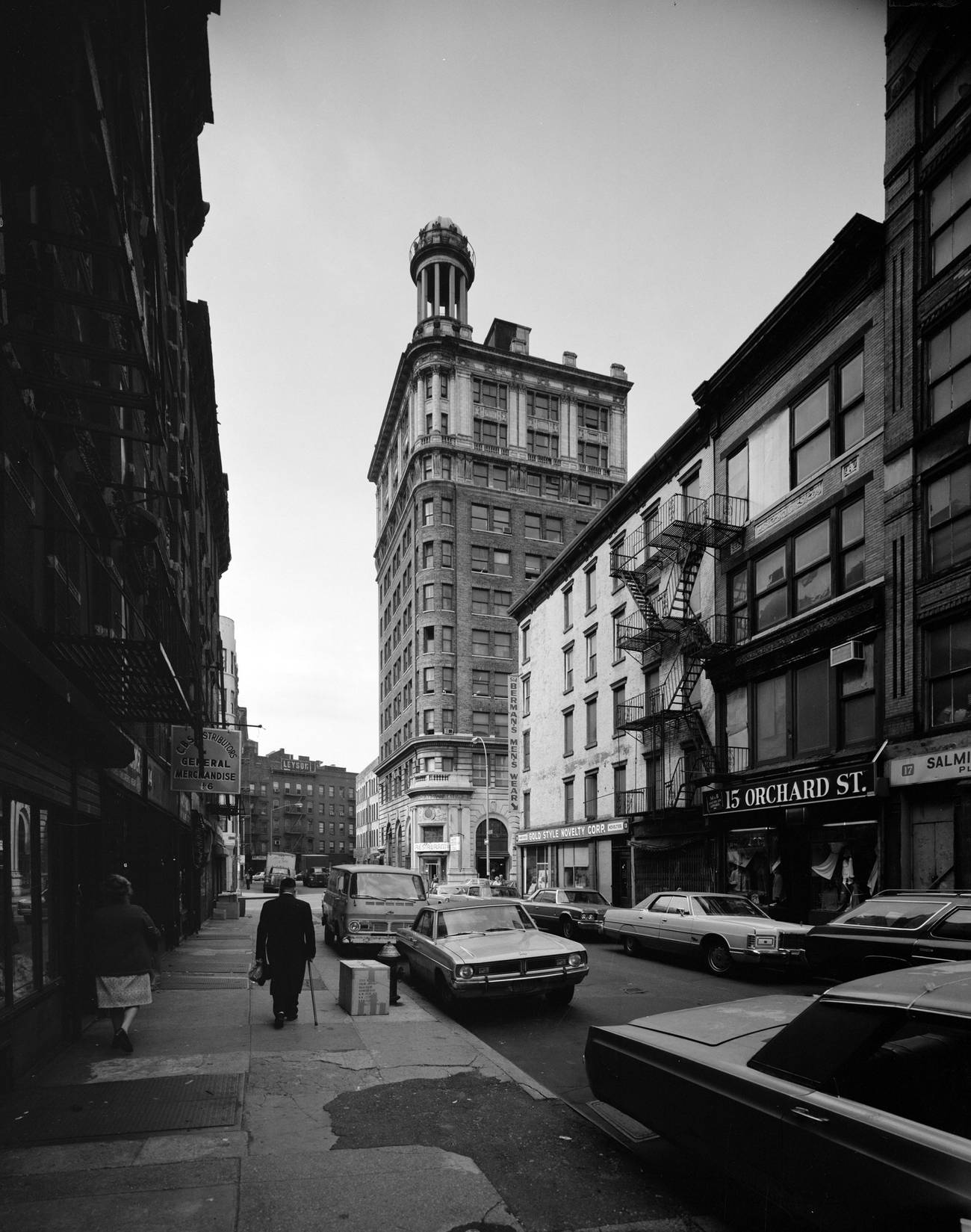Luxury on the Lower East Side
A new hotel rises on the site of a century-old bank that was once essential for the neighborhood’s Jewish immigrants




Bank buildings were once essential elements of the American civic landscape of the early 20th century. Monuments to capitalism, they exuded confidence by dint of their imposing limestone exteriors and equally imposing high-ceilinged interiors of marble and bronze. Today when local banks are more akin to fast food joints than to a “temple of finance,” it’s hard to summon up the hold they once had on the body politic: a respite from the humdrum, a place to linger, to lift one’s spirits. The only contemporary public sites that come close to providing a similar experience are hotels—the ritzier, the better.
When, in a stunning act of synthesis, a former bank becomes a hotel—luxury squared—possibilities abound. Consider, for instance, the recent opening of Nine Orchard, a posh hostelry located in the heart of the Lower East Side, a neighborhood once assailed as a “great ghetto” and currently trumpeted as the vortex of cool. The former home of S. Jarmulowsky’s Bank, which, back in the day, converted kronen, rubles, and zlotys into dollars, has now undergone a conversion all its own, the price of a night’s stay tantamount to what, in the late 19th century, might have comprised the sum total of an immigrant’s passbook.
Thanks to a thoroughgoing restoration, the building, which had fallen on hard times, its appealing presence obscured and even mocked by scaffolding, has been returned to its “Neo-Renaissance splendor” and its “outstanding details,” promises the hotel’s website “can now, once again, be appreciated and admired by visitors.”
Founded in 1873 by Sender Jarmulowsky, himself a newly arrived East European immigrant, the first Jewish-owned bank on the Lower East Side sold steamship tickets on the installment plan; provided credit, enabling local residents to expand their businesses; gave them a place, other than their mattresses, to put aside their earnings for a rainy day; and facilitated the transmission of money back home. “Jarmulowsky’s banking business has been a symbol for honest dealing during, one might say, the entire exodus of Jews from Russia,” said the American Hebrew in 1912.
A self-effacing, pious, and big-hearted man, Sender Jarmulowsky operated his banking enterprise from a modest five-story building on the corner of Orchard and Canal streets: 54 Canal St. was its address. Until he moved uptown along with many of his co-religionists and depositors, Jarmulowsky and his family lived in the neighborhood and supported its many institutions, among them the Eldridge Street Synagogue.
At the time of his death, in June 1912, some of his eulogizers maintained that, given his good deeds, the deceased’s reputation was certain to be immortalized. I’m not sure about that, but the name “S. Jarmulowsky” does live on: It’s gracefully carved into the lintel above the entrance to his bank, which had moved into grand new quarters only a few weeks earlier.
Occupying the very same site it had inhabited for decades, the new and improved bank of 12 stories was an “architectural wonder,” and, by its proprietor’s lights, “one of the most beautiful and secure bank buildings in the world.” Everything about the structure—its scale, creamy limestone exterior, and lavish interior appointments—stood out and apart from its grim and grimy surroundings. You couldn’t miss it.
S. Jarmulowsky’s Bank, trumpeted full-page advertisements that had been placed in Jewish newspapers that ranged from Orthodox-leaning ones such as the Hebrew Standard, to left-leaning ones like the Forverts, is “the largest, safest and most comfortable temple of finance built for you.” Hoping for even more depositors than the large number it already had on hand, S. Jarmulowsky tantalized them with the promise that, when opening a new account, they would receive “magnificent souvenirs”—a piggy bank, perhaps? Other come-hither gestures included extra interest on deposits along with the security that came from trusting their treasures to a fully capitalized bank with fireproof and even burglar-proof safe deposit boxes.
Why Sender Jarmulowsky decided to go big after so many years is something of a mystery. After all, his sons, Meyer and Louis, had beat him to the punch nearly 10 years earlier when, in 1903, they established their own private bank, M & L Jarmulowsky, at 165 East Broadway, just a few blocks away from their father’s gescheft. Hailed as a “Jewish Temple of Finance,” their facility boasted so many bells and whistles—an Otis elevator, stained glass windows, and electric lights—visitors might think they were in a “visionary fairyland.” Besides, crowed some of the local residents, the bank attested to their collective determination to make something of themselves, serving as a “sermon without words of duty and principle.”
What took Papa Jarmulowsky so long to follow suit? I suspect it was a matter of keeping up with the times—and the Jewish Joneses. Once the only game in town, S. Jarmulowsky’s Bank faced growing competition in the years immediately preceding WWI, as more and more banks took root on the Lower East Side. No longer could he trust to his reputation alone to draw and retain customers. By then, reported the American Hebrew, whose coverage of the Jewish banking scene was unusually extensive, a “fusillade of full-page advertisements in all the Yiddish newspapers” touted the merits of several rival establishments, giving rise to a “remarkable expenditure of printers’ ink”—and, in turn, to a panoply of banking opportunities.
Neighborhood residents in 1913 could now trust to Max Kobre’s Bank at 41 Canal St. to keep their “slender means” safe. To make sure they would be fully conversant with America’s monetary system as well as with the ins and outs of savings accounts, checking accounts, and the proper maintenance of a passbook, or a bank-bikhl, it published and distributed a Yiddish booklet, Der Mensch un Dos Gelt, to keep depositors well informed.
Despite this assist, more jittery patrons might have preferred to keep their dollars with the Bank of the United States, on Delancey Street, whose name—at once ruse and reassurance—implied stability in the form of government backing. The institution, though, was not owned and operated by the feds, but by the members of the Marcus family who had done well for themselves in the garment trade.
Sadly, Sender Jarmulowsky died only a few weeks after his eponymous edifice opened for business. Fortunately, he wasn’t around to see its reputation take quite a tumble, from which it never recovered. With the eruption of WWI, “stricken” depositors, seeking to withdraw their savings to send to family back home, generated a run on the bank’s assets. Though S. Jarmulowsky’s officers sought publicly to assure their clientele that its money was safe and sound and that the bank had enough on hand to cover any and all withdrawals, their appeals fell on deaf ears. It didn’t take much for customers of this institution, as well as those of most of the neighboring banks, to succumb to panic—and, while waiting nervously to withdraw their money, to riot on the streets—which then prompted the State Banking Department to step in and close its doors. For good.
In the decades that followed, what had once been briefly hailed as the pride of the Lower East Side housed a steady succession of tenants who made things, from the H.W. Perlman piano company, whose instruments were “guaranteed for a lifetime,” to Chinese clothing manufacturers until, one by one, they left the building. As late as 2012, The New York Times reported that for years, 54 Canal St. “has been on and off the market, and today it is dormant, awaiting its next incarnation—hotel? condominium? Maybe an Apple store?”
A decade later, we have the answer: In June, the former bank building made its debut as a hotel named Nine Orchard.
Having read on its website that the facility was “housed in an iconic Lower East Side landmark,” the product of a “decade-long mission to restore the building to its former glory,” and of how “with the support of the community and the expertise of many, the goal of reinvention was completed,” I was eager to see for myself what all the fuss was about by paying Nine Orchard a visit. (No, I didn’t spend the night.)
The building now glistens and gleams as it did a century ago, its handsome exterior enhanced by artful arrangements of abundant greenery and the addition of benches that beckon. Its interior, though, is something else again: intimate rather than grand. What had once been the first floor “banking room”—an expansive, even formidable public space, whose vaulted ceiling seemed to reach to the heavens—has now been reconfigured, rent in two to accommodate a reception area, with its accompanying paraphernalia of suitcases, shopping bags, and luggage carts, and a lobby-cum-lounge which one enters through a pair of curtains that wouldn’t have been out of place in a Victorian parlor.
Sunlight streams in through the lounge’s oversize windows, an original feature of the building’s first floor; the beautiful ceiling, which has been uncovered and “lovingly” restored, looms gloriously overhead, while a “painstakingly replicated” clock, flanked, appropriately enough, by a pair of cornucopias, marks the passage of time.
Otherwise, little remains of the imposing room where, a century earlier, customers had conducted their business with tellers who inhabited a large cagelike structure outfitted in marble and bronze. It has now been transformed into a warm, inviting. and heavily upholstered space, awash in plants and oversize floral displays, where one is apt to feel cossetted, even charmed, rather than awed or anxious.
After resisting the temptation to curl up with a cup of tea and a good book, I approached the folks at the reception desk and, trotting out my bona fides as an historian, inquired if I might have a peek at some of the other restored public spaces. Nothing doing. I was politely but firmly told that the lounge area was the only space open to the public and that everything else on the premises was “private, for guests.”
This wasn’t the only thing I missed seeing. More conspicuously absent, near as I could tell from my limited exposure, were any allusions, either visual or textual, to the building’s past, or to its present restoration, or to its longstanding relationship to the neighborhood: No “before and after” pictures on the walls; no sepia-toned images of the Lower East Side; no history handouts at the desk; not even a plaque saying “Jarmulowsky was here.”
Who? Tellingly, guests no longer enter the premises through the proudly ornamented entry that still bears Jarmulowsky’s name, its threshold angled just so, straddling both Canal and Orchard streets. They walk right past it, headed for the hotel’s entrance, which has been repositioned a few yards away, down Orchard Street, giving birth to a new address as well as a new name.
At Nine Orchard, history lives off-site: on the hotel’s digital pages, where it functions as a flourish, at best, and as a marketing tool, at worst. Both iterations strike me as the 21st-century equivalent of slumming, the longstanding practice of cultural voyeurism, in which the well-heeled and deep-pocketed ventured forth into an urban slum for fun rather than reckoning. A hundred years ago, Harlem was the venue of choice. These days, if the hotel’s apparent success is any indication, contemporary tourists with equally deep pockets are drawn to the Lower East Side.
Still, if you’re looking to combine a good night’s sleep and a cool vibe with even a smidgen’s worth of local history, I wouldn’t bank on finding it at 9 Orchard St.
Jenna Weissman Joselit, the Charles E. Smith Professor of Judaic Studies & Professor of History at the George Washington University, is currently at work on a biography of Mordecai M. Kaplan.